Emotional intelligence and diversity -
VerifiedAdded on 2022/09/09
|10
|1699
|34
AI Summary
Contribute Materials
Your contribution can guide someone’s learning journey. Share your
documents today.
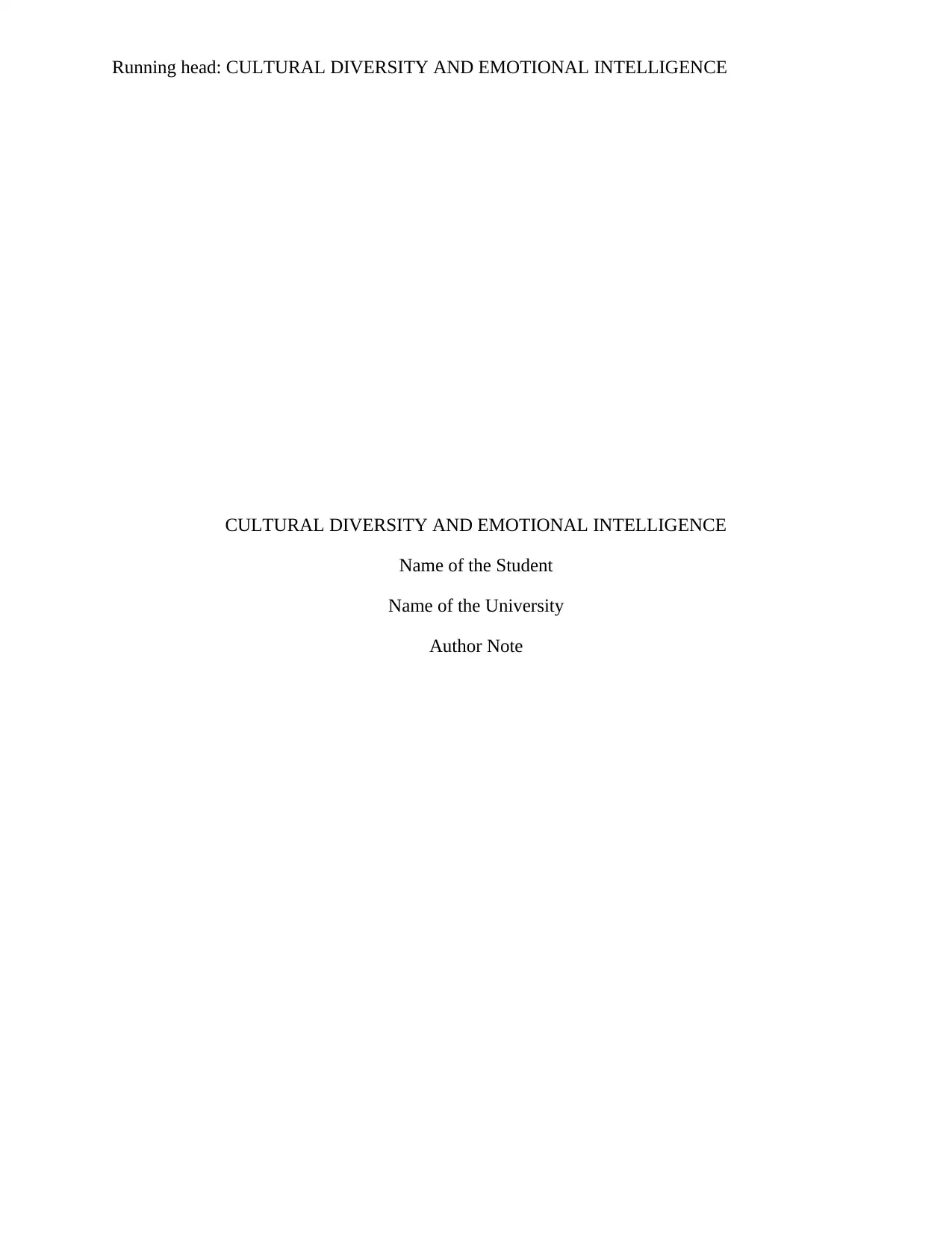
Running head: CULTURAL DIVERSITY AND EMOTIONAL INTELLIGENCE
CULTURAL DIVERSITY AND EMOTIONAL INTELLIGENCE
Name of the Student
Name of the University
Author Note
CULTURAL DIVERSITY AND EMOTIONAL INTELLIGENCE
Name of the Student
Name of the University
Author Note
Secure Best Marks with AI Grader
Need help grading? Try our AI Grader for instant feedback on your assignments.
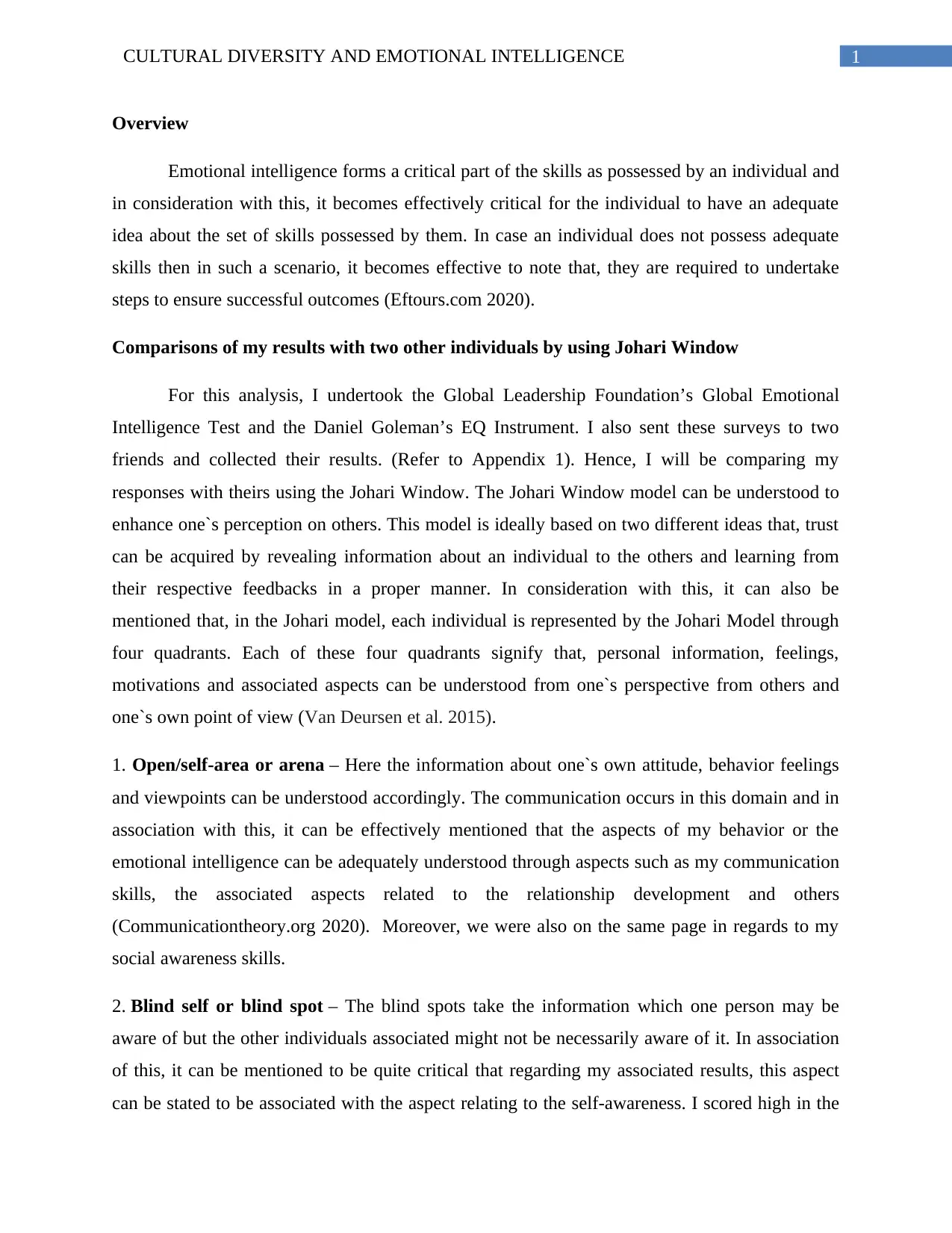
1CULTURAL DIVERSITY AND EMOTIONAL INTELLIGENCE
Overview
Emotional intelligence forms a critical part of the skills as possessed by an individual and
in consideration with this, it becomes effectively critical for the individual to have an adequate
idea about the set of skills possessed by them. In case an individual does not possess adequate
skills then in such a scenario, it becomes effective to note that, they are required to undertake
steps to ensure successful outcomes (Eftours.com 2020).
Comparisons of my results with two other individuals by using Johari Window
For this analysis, I undertook the Global Leadership Foundation’s Global Emotional
Intelligence Test and the Daniel Goleman’s EQ Instrument. I also sent these surveys to two
friends and collected their results. (Refer to Appendix 1). Hence, I will be comparing my
responses with theirs using the Johari Window. The Johari Window model can be understood to
enhance one`s perception on others. This model is ideally based on two different ideas that, trust
can be acquired by revealing information about an individual to the others and learning from
their respective feedbacks in a proper manner. In consideration with this, it can also be
mentioned that, in the Johari model, each individual is represented by the Johari Model through
four quadrants. Each of these four quadrants signify that, personal information, feelings,
motivations and associated aspects can be understood from one`s perspective from others and
one`s own point of view (Van Deursen et al. 2015).
1. Open/self-area or arena – Here the information about one`s own attitude, behavior feelings
and viewpoints can be understood accordingly. The communication occurs in this domain and in
association with this, it can be effectively mentioned that the aspects of my behavior or the
emotional intelligence can be adequately understood through aspects such as my communication
skills, the associated aspects related to the relationship development and others
(Communicationtheory.org 2020). Moreover, we were also on the same page in regards to my
social awareness skills.
2. Blind self or blind spot – The blind spots take the information which one person may be
aware of but the other individuals associated might not be necessarily aware of it. In association
of this, it can be mentioned to be quite critical that regarding my associated results, this aspect
can be stated to be associated with the aspect relating to the self-awareness. I scored high in the
Overview
Emotional intelligence forms a critical part of the skills as possessed by an individual and
in consideration with this, it becomes effectively critical for the individual to have an adequate
idea about the set of skills possessed by them. In case an individual does not possess adequate
skills then in such a scenario, it becomes effective to note that, they are required to undertake
steps to ensure successful outcomes (Eftours.com 2020).
Comparisons of my results with two other individuals by using Johari Window
For this analysis, I undertook the Global Leadership Foundation’s Global Emotional
Intelligence Test and the Daniel Goleman’s EQ Instrument. I also sent these surveys to two
friends and collected their results. (Refer to Appendix 1). Hence, I will be comparing my
responses with theirs using the Johari Window. The Johari Window model can be understood to
enhance one`s perception on others. This model is ideally based on two different ideas that, trust
can be acquired by revealing information about an individual to the others and learning from
their respective feedbacks in a proper manner. In consideration with this, it can also be
mentioned that, in the Johari model, each individual is represented by the Johari Model through
four quadrants. Each of these four quadrants signify that, personal information, feelings,
motivations and associated aspects can be understood from one`s perspective from others and
one`s own point of view (Van Deursen et al. 2015).
1. Open/self-area or arena – Here the information about one`s own attitude, behavior feelings
and viewpoints can be understood accordingly. The communication occurs in this domain and in
association with this, it can be effectively mentioned that the aspects of my behavior or the
emotional intelligence can be adequately understood through aspects such as my communication
skills, the associated aspects related to the relationship development and others
(Communicationtheory.org 2020). Moreover, we were also on the same page in regards to my
social awareness skills.
2. Blind self or blind spot – The blind spots take the information which one person may be
aware of but the other individuals associated might not be necessarily aware of it. In association
of this, it can be mentioned to be quite critical that regarding my associated results, this aspect
can be stated to be associated with the aspect relating to the self-awareness. I scored high in the
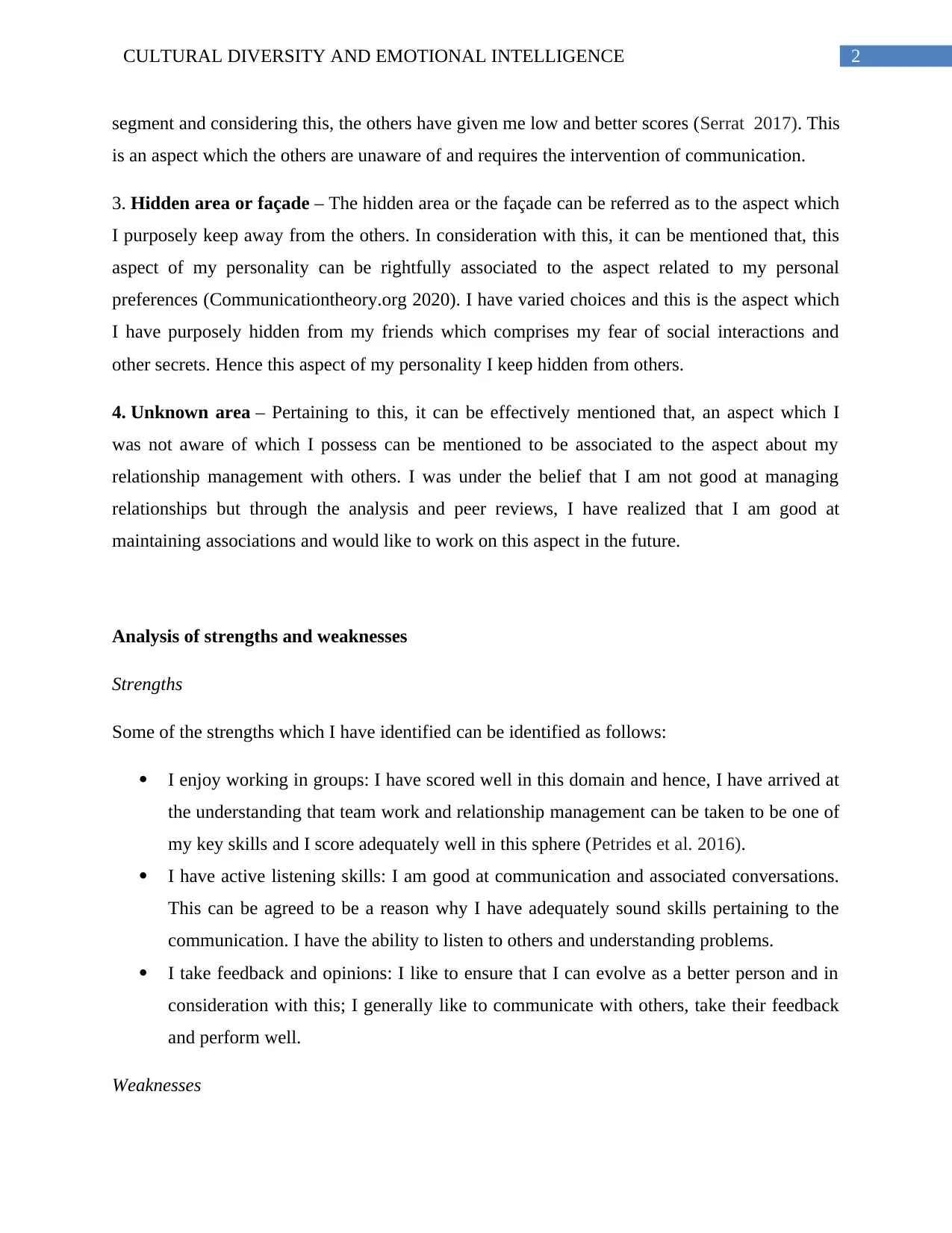
2CULTURAL DIVERSITY AND EMOTIONAL INTELLIGENCE
segment and considering this, the others have given me low and better scores (Serrat 2017). This
is an aspect which the others are unaware of and requires the intervention of communication.
3. Hidden area or façade – The hidden area or the façade can be referred as to the aspect which
I purposely keep away from the others. In consideration with this, it can be mentioned that, this
aspect of my personality can be rightfully associated to the aspect related to my personal
preferences (Communicationtheory.org 2020). I have varied choices and this is the aspect which
I have purposely hidden from my friends which comprises my fear of social interactions and
other secrets. Hence this aspect of my personality I keep hidden from others.
4. Unknown area – Pertaining to this, it can be effectively mentioned that, an aspect which I
was not aware of which I possess can be mentioned to be associated to the aspect about my
relationship management with others. I was under the belief that I am not good at managing
relationships but through the analysis and peer reviews, I have realized that I am good at
maintaining associations and would like to work on this aspect in the future.
Analysis of strengths and weaknesses
Strengths
Some of the strengths which I have identified can be identified as follows:
I enjoy working in groups: I have scored well in this domain and hence, I have arrived at
the understanding that team work and relationship management can be taken to be one of
my key skills and I score adequately well in this sphere (Petrides et al. 2016).
I have active listening skills: I am good at communication and associated conversations.
This can be agreed to be a reason why I have adequately sound skills pertaining to the
communication. I have the ability to listen to others and understanding problems.
I take feedback and opinions: I like to ensure that I can evolve as a better person and in
consideration with this; I generally like to communicate with others, take their feedback
and perform well.
Weaknesses
segment and considering this, the others have given me low and better scores (Serrat 2017). This
is an aspect which the others are unaware of and requires the intervention of communication.
3. Hidden area or façade – The hidden area or the façade can be referred as to the aspect which
I purposely keep away from the others. In consideration with this, it can be mentioned that, this
aspect of my personality can be rightfully associated to the aspect related to my personal
preferences (Communicationtheory.org 2020). I have varied choices and this is the aspect which
I have purposely hidden from my friends which comprises my fear of social interactions and
other secrets. Hence this aspect of my personality I keep hidden from others.
4. Unknown area – Pertaining to this, it can be effectively mentioned that, an aspect which I
was not aware of which I possess can be mentioned to be associated to the aspect about my
relationship management with others. I was under the belief that I am not good at managing
relationships but through the analysis and peer reviews, I have realized that I am good at
maintaining associations and would like to work on this aspect in the future.
Analysis of strengths and weaknesses
Strengths
Some of the strengths which I have identified can be identified as follows:
I enjoy working in groups: I have scored well in this domain and hence, I have arrived at
the understanding that team work and relationship management can be taken to be one of
my key skills and I score adequately well in this sphere (Petrides et al. 2016).
I have active listening skills: I am good at communication and associated conversations.
This can be agreed to be a reason why I have adequately sound skills pertaining to the
communication. I have the ability to listen to others and understanding problems.
I take feedback and opinions: I like to ensure that I can evolve as a better person and in
consideration with this; I generally like to communicate with others, take their feedback
and perform well.
Weaknesses
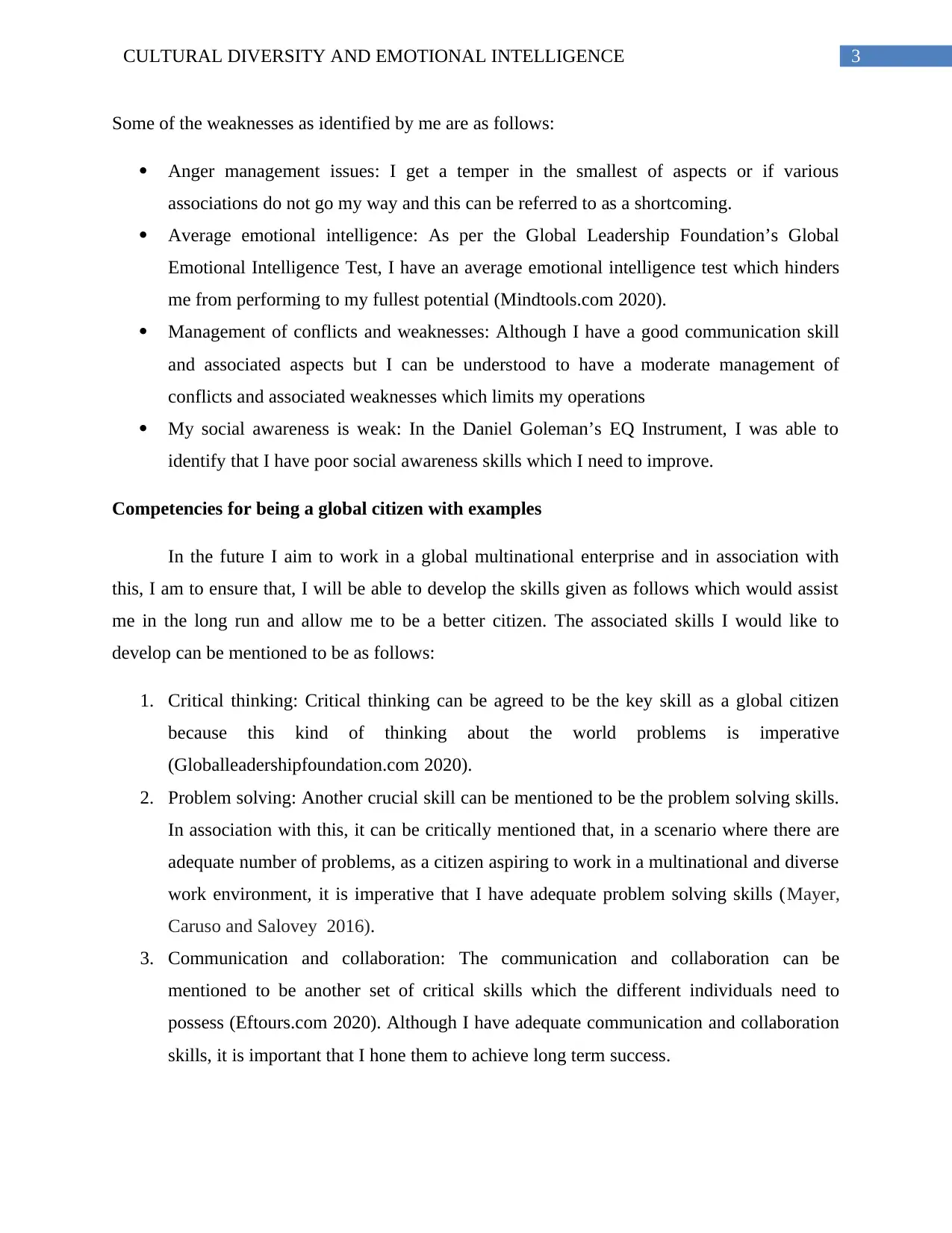
3CULTURAL DIVERSITY AND EMOTIONAL INTELLIGENCE
Some of the weaknesses as identified by me are as follows:
Anger management issues: I get a temper in the smallest of aspects or if various
associations do not go my way and this can be referred to as a shortcoming.
Average emotional intelligence: As per the Global Leadership Foundation’s Global
Emotional Intelligence Test, I have an average emotional intelligence test which hinders
me from performing to my fullest potential (Mindtools.com 2020).
Management of conflicts and weaknesses: Although I have a good communication skill
and associated aspects but I can be understood to have a moderate management of
conflicts and associated weaknesses which limits my operations
My social awareness is weak: In the Daniel Goleman’s EQ Instrument, I was able to
identify that I have poor social awareness skills which I need to improve.
Competencies for being a global citizen with examples
In the future I aim to work in a global multinational enterprise and in association with
this, I am to ensure that, I will be able to develop the skills given as follows which would assist
me in the long run and allow me to be a better citizen. The associated skills I would like to
develop can be mentioned to be as follows:
1. Critical thinking: Critical thinking can be agreed to be the key skill as a global citizen
because this kind of thinking about the world problems is imperative
(Globalleadershipfoundation.com 2020).
2. Problem solving: Another crucial skill can be mentioned to be the problem solving skills.
In association with this, it can be critically mentioned that, in a scenario where there are
adequate number of problems, as a citizen aspiring to work in a multinational and diverse
work environment, it is imperative that I have adequate problem solving skills (Mayer,
Caruso and Salovey 2016).
3. Communication and collaboration: The communication and collaboration can be
mentioned to be another set of critical skills which the different individuals need to
possess (Eftours.com 2020). Although I have adequate communication and collaboration
skills, it is important that I hone them to achieve long term success.
Some of the weaknesses as identified by me are as follows:
Anger management issues: I get a temper in the smallest of aspects or if various
associations do not go my way and this can be referred to as a shortcoming.
Average emotional intelligence: As per the Global Leadership Foundation’s Global
Emotional Intelligence Test, I have an average emotional intelligence test which hinders
me from performing to my fullest potential (Mindtools.com 2020).
Management of conflicts and weaknesses: Although I have a good communication skill
and associated aspects but I can be understood to have a moderate management of
conflicts and associated weaknesses which limits my operations
My social awareness is weak: In the Daniel Goleman’s EQ Instrument, I was able to
identify that I have poor social awareness skills which I need to improve.
Competencies for being a global citizen with examples
In the future I aim to work in a global multinational enterprise and in association with
this, I am to ensure that, I will be able to develop the skills given as follows which would assist
me in the long run and allow me to be a better citizen. The associated skills I would like to
develop can be mentioned to be as follows:
1. Critical thinking: Critical thinking can be agreed to be the key skill as a global citizen
because this kind of thinking about the world problems is imperative
(Globalleadershipfoundation.com 2020).
2. Problem solving: Another crucial skill can be mentioned to be the problem solving skills.
In association with this, it can be critically mentioned that, in a scenario where there are
adequate number of problems, as a citizen aspiring to work in a multinational and diverse
work environment, it is imperative that I have adequate problem solving skills (Mayer,
Caruso and Salovey 2016).
3. Communication and collaboration: The communication and collaboration can be
mentioned to be another set of critical skills which the different individuals need to
possess (Eftours.com 2020). Although I have adequate communication and collaboration
skills, it is important that I hone them to achieve long term success.
Secure Best Marks with AI Grader
Need help grading? Try our AI Grader for instant feedback on your assignments.
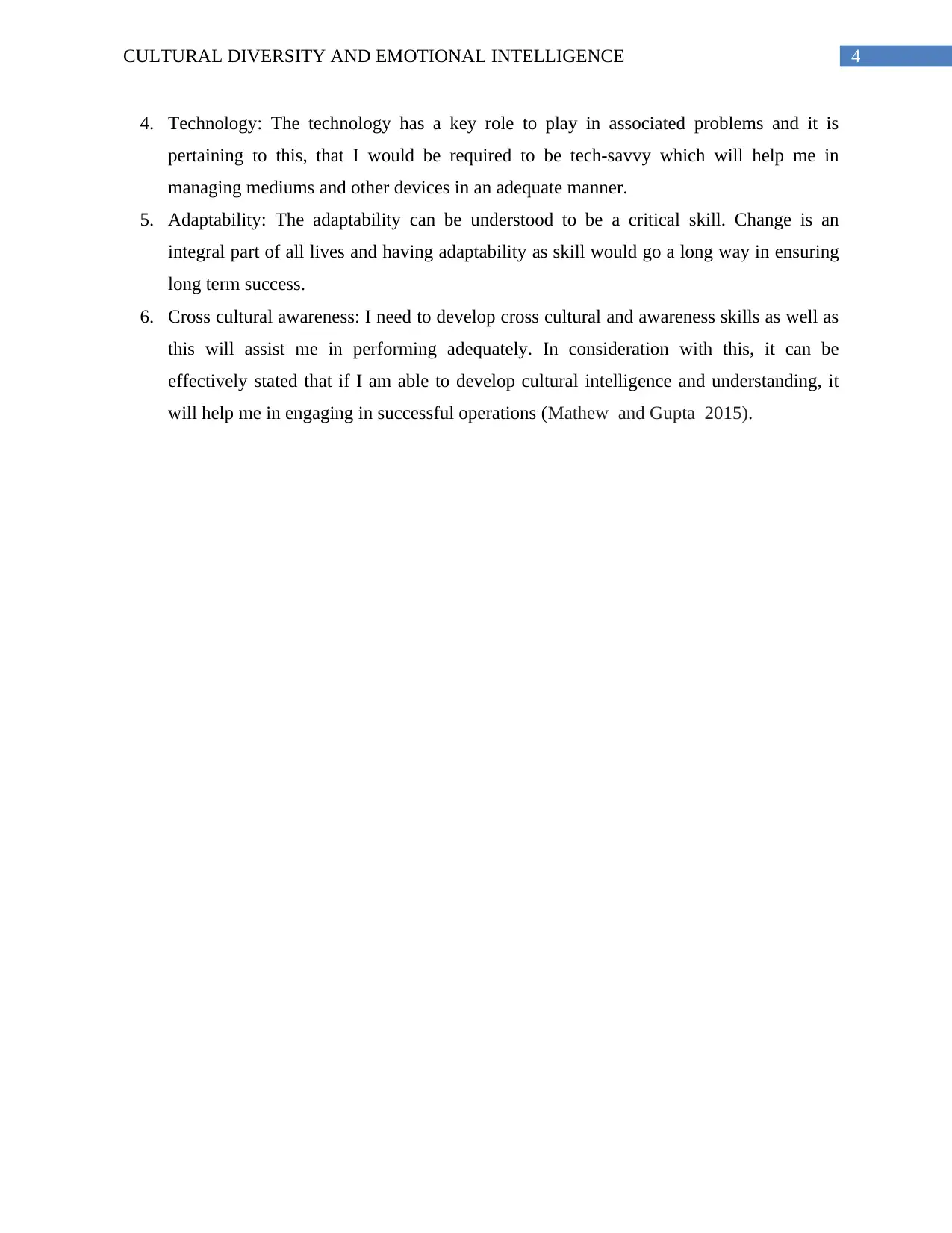
4CULTURAL DIVERSITY AND EMOTIONAL INTELLIGENCE
4. Technology: The technology has a key role to play in associated problems and it is
pertaining to this, that I would be required to be tech-savvy which will help me in
managing mediums and other devices in an adequate manner.
5. Adaptability: The adaptability can be understood to be a critical skill. Change is an
integral part of all lives and having adaptability as skill would go a long way in ensuring
long term success.
6. Cross cultural awareness: I need to develop cross cultural and awareness skills as well as
this will assist me in performing adequately. In consideration with this, it can be
effectively stated that if I am able to develop cultural intelligence and understanding, it
will help me in engaging in successful operations (Mathew and Gupta 2015).
4. Technology: The technology has a key role to play in associated problems and it is
pertaining to this, that I would be required to be tech-savvy which will help me in
managing mediums and other devices in an adequate manner.
5. Adaptability: The adaptability can be understood to be a critical skill. Change is an
integral part of all lives and having adaptability as skill would go a long way in ensuring
long term success.
6. Cross cultural awareness: I need to develop cross cultural and awareness skills as well as
this will assist me in performing adequately. In consideration with this, it can be
effectively stated that if I am able to develop cultural intelligence and understanding, it
will help me in engaging in successful operations (Mathew and Gupta 2015).
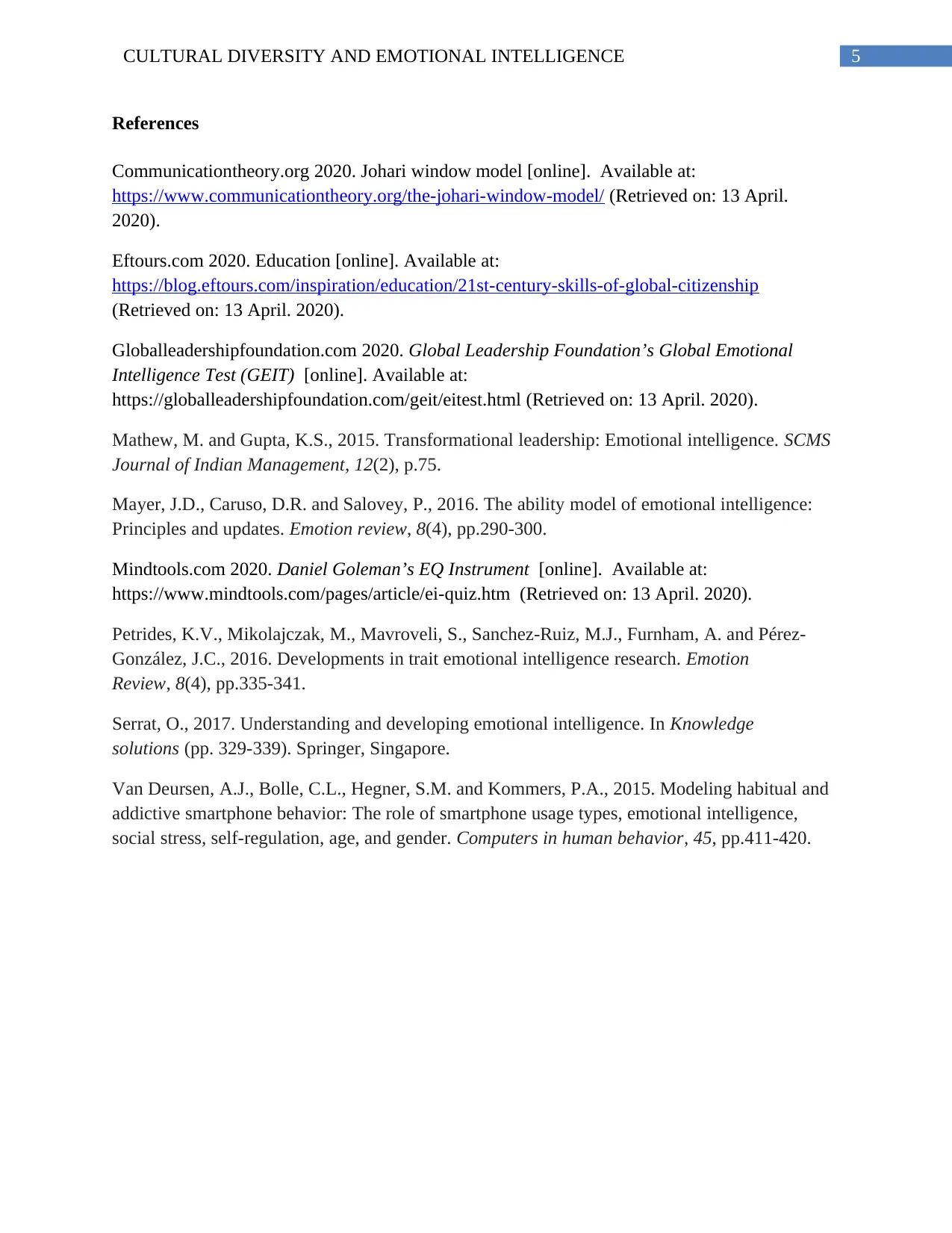
5CULTURAL DIVERSITY AND EMOTIONAL INTELLIGENCE
References
Communicationtheory.org 2020. Johari window model [online]. Available at:
https://www.communicationtheory.org/the-johari-window-model/ (Retrieved on: 13 April.
2020).
Eftours.com 2020. Education [online]. Available at:
https://blog.eftours.com/inspiration/education/21st-century-skills-of-global-citizenship
(Retrieved on: 13 April. 2020).
Globalleadershipfoundation.com 2020. Global Leadership Foundation’s Global Emotional
Intelligence Test (GEIT) [online]. Available at:
https://globalleadershipfoundation.com/geit/eitest.html (Retrieved on: 13 April. 2020).
Mathew, M. and Gupta, K.S., 2015. Transformational leadership: Emotional intelligence. SCMS
Journal of Indian Management, 12(2), p.75.
Mayer, J.D., Caruso, D.R. and Salovey, P., 2016. The ability model of emotional intelligence:
Principles and updates. Emotion review, 8(4), pp.290-300.
Mindtools.com 2020. Daniel Goleman’s EQ Instrument [online]. Available at:
https://www.mindtools.com/pages/article/ei-quiz.htm (Retrieved on: 13 April. 2020).
Petrides, K.V., Mikolajczak, M., Mavroveli, S., Sanchez-Ruiz, M.J., Furnham, A. and Pérez-
González, J.C., 2016. Developments in trait emotional intelligence research. Emotion
Review, 8(4), pp.335-341.
Serrat, O., 2017. Understanding and developing emotional intelligence. In Knowledge
solutions (pp. 329-339). Springer, Singapore.
Van Deursen, A.J., Bolle, C.L., Hegner, S.M. and Kommers, P.A., 2015. Modeling habitual and
addictive smartphone behavior: The role of smartphone usage types, emotional intelligence,
social stress, self-regulation, age, and gender. Computers in human behavior, 45, pp.411-420.
References
Communicationtheory.org 2020. Johari window model [online]. Available at:
https://www.communicationtheory.org/the-johari-window-model/ (Retrieved on: 13 April.
2020).
Eftours.com 2020. Education [online]. Available at:
https://blog.eftours.com/inspiration/education/21st-century-skills-of-global-citizenship
(Retrieved on: 13 April. 2020).
Globalleadershipfoundation.com 2020. Global Leadership Foundation’s Global Emotional
Intelligence Test (GEIT) [online]. Available at:
https://globalleadershipfoundation.com/geit/eitest.html (Retrieved on: 13 April. 2020).
Mathew, M. and Gupta, K.S., 2015. Transformational leadership: Emotional intelligence. SCMS
Journal of Indian Management, 12(2), p.75.
Mayer, J.D., Caruso, D.R. and Salovey, P., 2016. The ability model of emotional intelligence:
Principles and updates. Emotion review, 8(4), pp.290-300.
Mindtools.com 2020. Daniel Goleman’s EQ Instrument [online]. Available at:
https://www.mindtools.com/pages/article/ei-quiz.htm (Retrieved on: 13 April. 2020).
Petrides, K.V., Mikolajczak, M., Mavroveli, S., Sanchez-Ruiz, M.J., Furnham, A. and Pérez-
González, J.C., 2016. Developments in trait emotional intelligence research. Emotion
Review, 8(4), pp.335-341.
Serrat, O., 2017. Understanding and developing emotional intelligence. In Knowledge
solutions (pp. 329-339). Springer, Singapore.
Van Deursen, A.J., Bolle, C.L., Hegner, S.M. and Kommers, P.A., 2015. Modeling habitual and
addictive smartphone behavior: The role of smartphone usage types, emotional intelligence,
social stress, self-regulation, age, and gender. Computers in human behavior, 45, pp.411-420.
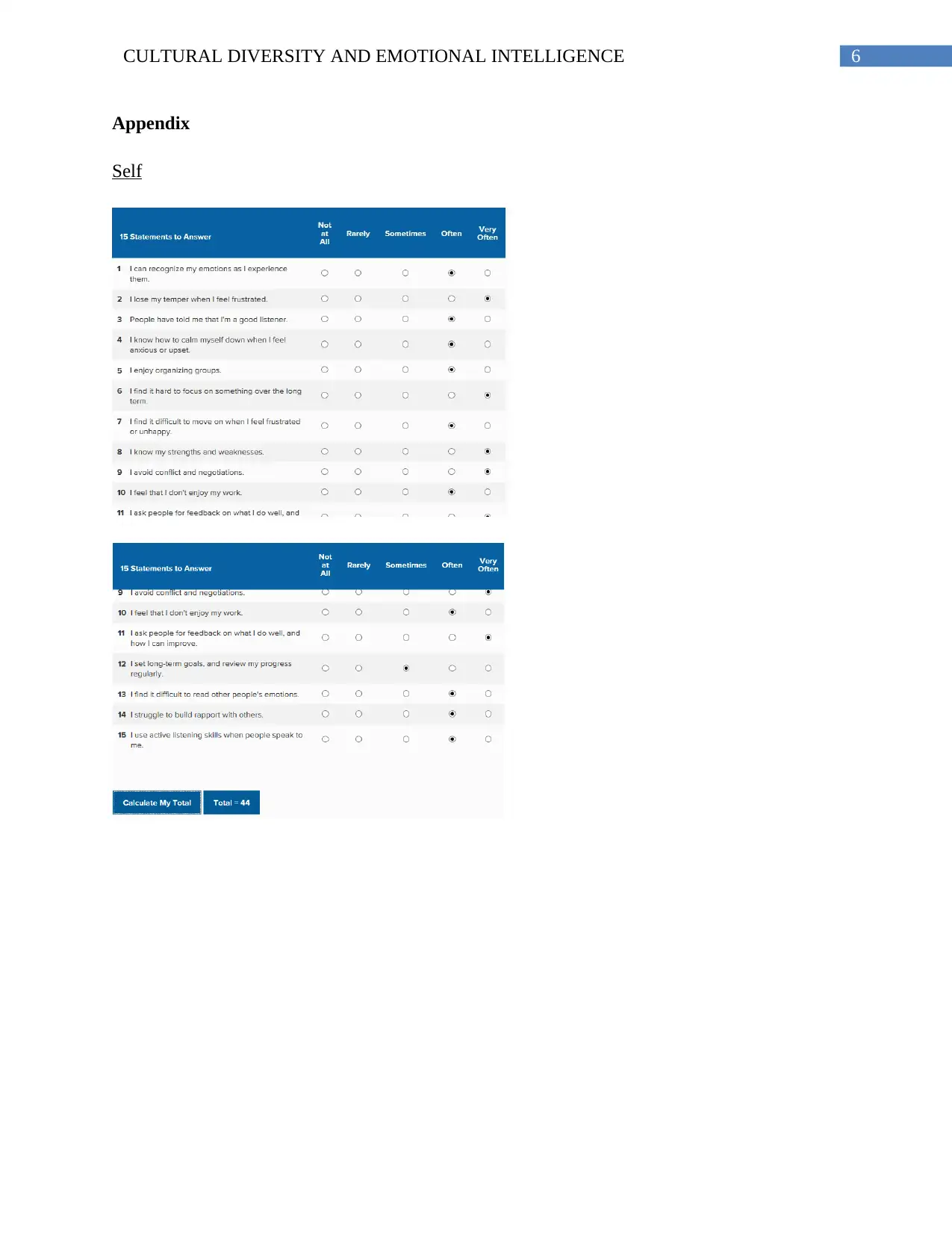
6CULTURAL DIVERSITY AND EMOTIONAL INTELLIGENCE
Appendix
Self
Appendix
Self
Paraphrase This Document
Need a fresh take? Get an instant paraphrase of this document with our AI Paraphraser
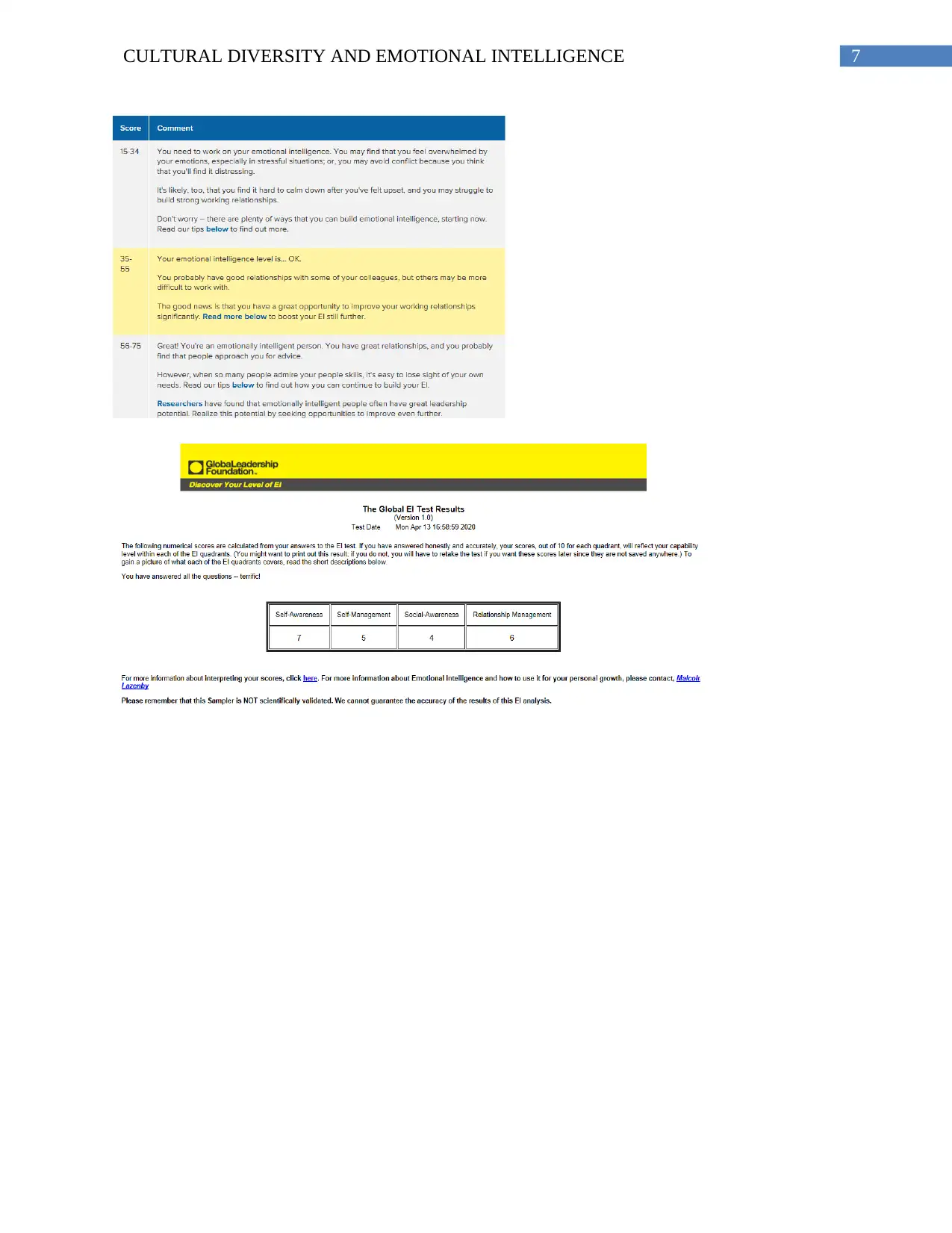
7CULTURAL DIVERSITY AND EMOTIONAL INTELLIGENCE
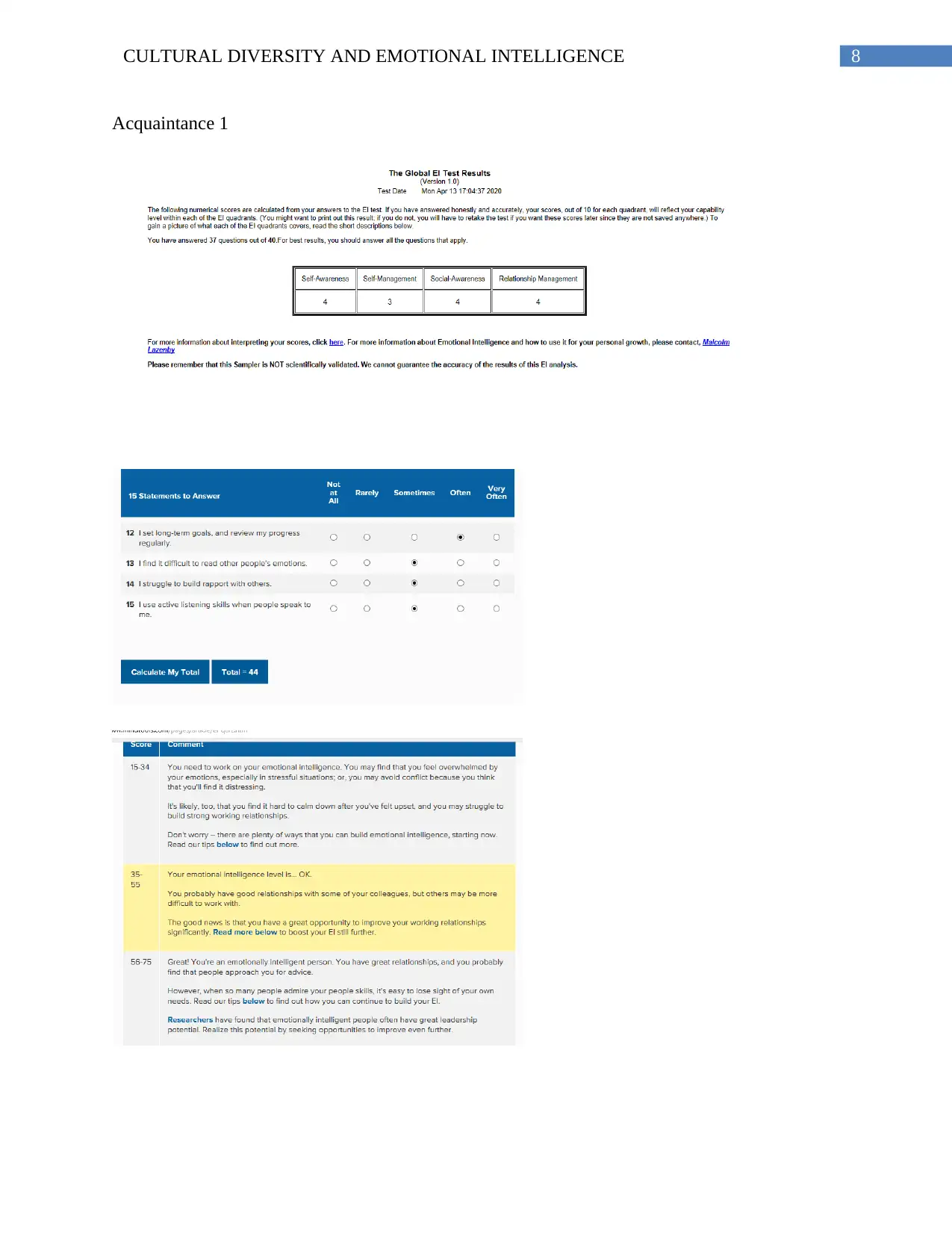
8CULTURAL DIVERSITY AND EMOTIONAL INTELLIGENCE
Acquaintance 1
Acquaintance 1
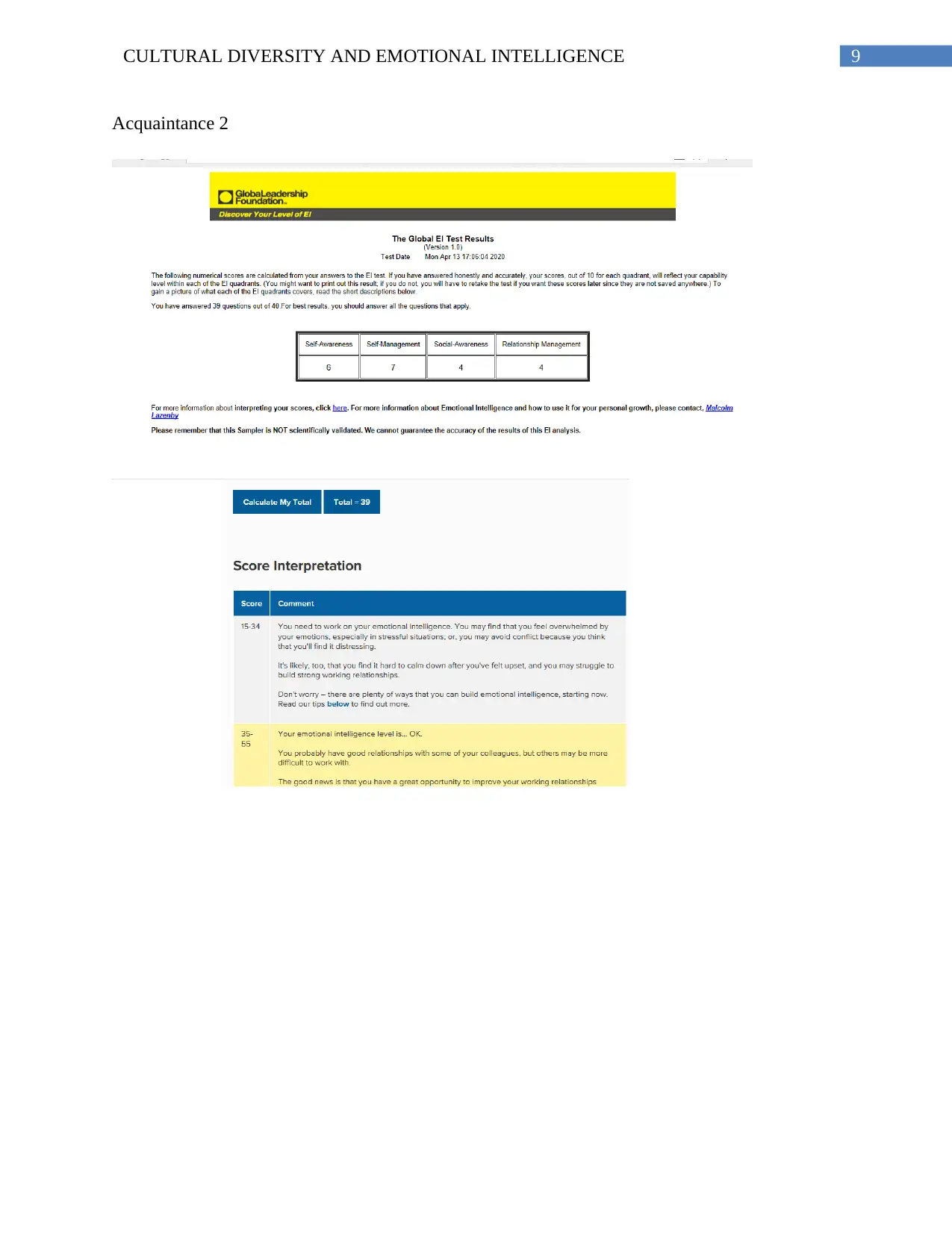
9CULTURAL DIVERSITY AND EMOTIONAL INTELLIGENCE
Acquaintance 2
Acquaintance 2
1 out of 10
Related Documents
Your All-in-One AI-Powered Toolkit for Academic Success.
+13062052269
info@desklib.com
Available 24*7 on WhatsApp / Email
![[object Object]](/_next/static/media/star-bottom.7253800d.svg)
Unlock your academic potential
© 2024 | Zucol Services PVT LTD | All rights reserved.





